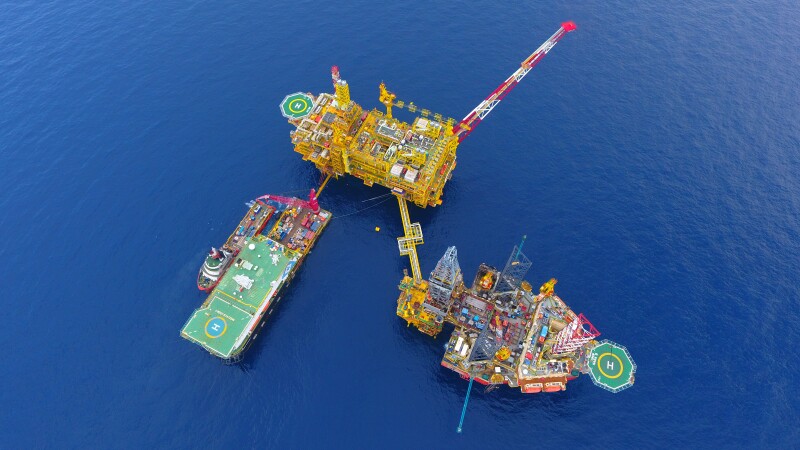Malaysia’s state-owned Petronas and its global partners drilled twice as many exploration wells in 2022 as in the year previous, scoring a 60% success rate as the southeast Asian country accelerates expansion of its offshore gas resources to support its growth as an exporter of liquefied natural gas (LNG).
In reporting year-end results, Petronas said its 2022 exploration campaign had discovered 10 new hydrocarbon prospects: eight off the coast of Sarawak, and one each off the coasts of Sabah and Peninsular Malaysia.
Out of awards made in Malaysia’s 2022 licensing round, 16 wells were completed with two more in progress at year end. That was double the activity in 2021, Petronas Senior Vice President of Malaysia Petroleum Management (MPM), Mohamed Firouz Asnan, noted in a press release.
“Most of the discoveries can be quickly monetized at a lower cost given their proximity to the extensive network of existing infrastructure,” Firouz Asnan commented in a news release. Petronas said it expects production-sharing contracts (PSC) to be signed in February, followed by the launch of a 2023 bid round on further exploration targets.
Petronas Senior General Manager of Resource Exploration MPM, Azmir Zamri, said that Malaysia’s 2023 campaign anticipates that up to 30 more exploration wells could be drilled, potentially exceeding 2022 results.
The company’s own exploration and production subsidiary, Petronas Carigali, made the largest oil discovery in 2022, at the Nahara-1 well in Block SK306 within Sarawak’s Balingian province.
Other discoveries were announced in Sarawak’s Central Luconia, Western Luconia, and Baram provinces, which are among Malaysia’s most prolific basins and home to many gas fields.
Among the finds:
- Shell’s discoveries at the Inai-1 and Temu-1 wells in the MLNG Block in Central Luconia.
- Abu Dhabi-based Mubadala Energy struck more gas in Block SK320 at the Cengkih-1 well.
- In the emerging province of Western Luconia, ConocoPhillips drilled three exploration wells in Block WL4-00 and discovered gas at the Gagau-1 well while the Salam-3 and Benum-2 wells confirmed the extension of oil and gas accumulations in adjacent fault blocks.
- In the matured Baram province, Thailand’s PTTEP made another gas discovery in Block SK410B through the Paprika-1 well, where the giant Lang Lebah field was also discovered in 2019.
- In ultradeepwater Sabah, TotalEnergies made an oil and gas discovery at the Tepat-2 well in Block N within the emerging Sabah Trough province, further proving the extent of the earlier oil and gas discovery of Tepat-1 in 2018.
- Off the coast of Peninsular Malaysia, Hess found a new gas reservoir at the Bergading Deep-4 well in Block PM302 within the North Malay Basin.
Commenting on its discovery at Cengkih-1, Mubadala noted in a separate press release that preliminary analysis showed a significant gas column of more than 110 m within the pinnacle carbonate reef reservoir.
The Cengkih-1 exploration well is located near the Pegaga field which is within the SK320 Block and recently began to produce commercial quantities of gas. The Pegaga field recorded the discovery of 1 Tcf of additional gas in place, following the post-drill results which confirmed a larger and better-quality reservoir, according to Mubadala.
Mubadala Energy operates Block SK320, with a 55% participating interest in the PSC. Petronas Carigali Sdn Bhd and Sarawak Shell Berhad hold the remaining 45%. Mubadala Energy has made six gas discoveries since entering Malaysia in 2010 and represents a 75% success ratio, the company reported.
Malaysia’s quest to grow its resource base supports its ambitions as a global LNG producer. It was the fifth-largest global exporter of LNG in 2021, and its national oil and gas company, Petronas, ranked 4th among companies in LNG storage capacity as of July 2022, bested only by QatarEnergy, Cheniere Energy, and Shell which occupy first through third place respectively, according to Statistica.

Malaysia was Japan’s second-biggest LNG supplier 2021, providing about 10 million tons, according to Japanese trade data quoted by Reuters. Malaysia delivered 50 cargoes to Japan from October through December that year.
Boasting a capacity of 25.7 mtpa, the Malaysia LNG project is one of the largest LNG facilities in a single location in the world, according to Mitsubishi, which is a partner in the project which supplies not only Japan but also South Korea, Taiwan, and China.
Meanwhile, Petronas subsidiary, Petronas Petróleo Brasil Ltda. (PPBL) and its partners won the Agua Marinha exploration block during the first cycle of Brazil’s open acreage under a production-sharing regime bid in Rio de Janeiro in December.
PPBL will hold a 20% participating interest in the block located in the Campos Basin, with Brazil’s Petrobras (30%) as the operator, TotalEnergies (30%), and QatarEnergy (20%).
PPBL recently announced the first oil discovery at the 4-BRSA-1386D-RJS well in the pre-salt Sépia oil field in the Santos Basin. It has a 21% participating interest in the field, the company said in a news release.
PPBL also holds participating interests in the Tartaruga Verde (BM-C-36 Concession) and Module III of the Espadarte (Espadarte Concession) deepwater fields, as well as three deepwater exploration blocks, C-M-541, C-M-661, and C-M-715, in the Campos Basin.


